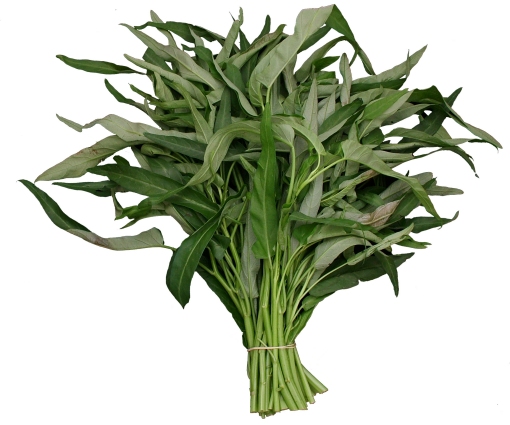
Whenever I dine at a Malay or Indonesian restaurant, it's almost a compulsion for me to order a plate of Kangkong Belacan. Here's why - when paired with steamed white rice, this glorious dish would take you to a dreamy gastronomic haven that you wished was your final destination. Ok, a little exaggeration and fond hope won't hurt, will it? In simpler terms, Kangkong Belacan is a must-have and will-love dish in the encyclopedia of Malay/Indonesian cuisine. The marriage of these leafy greens with the saltish belacan (Malay for "shrimp paste") and mildly hot chilli paste is one that is truly descended from food paradise. I love cooking this simple dish, which was one of the first dishes I made since I started learning the names of various vegetables.
 |
| Popularly known as kangkong in Southeast Asia, this vegetable carries other names too such as water glorybind, water spinach, water convolvulus and swamp cabbage |
The thing about kangkong that I have been advised by my mum is that, while they usually come in a large bouquet, do not be worried that you would have plenty of leftovers when you cook the whole bunch. The leaves shrink during the cooking process. Forget about eating just a few pieces like you would lettuce because one fork will grab a sizeable amount of kangkong and more often than not, you won't stop at just one serving. In fact, for a complete white rice-kangkong enjoyment, you shouldn't stop at just one serving.
At this point, I must highlight a little bit about belacan, which is the main ingredient in this dish. Belacan is a Malay word and is pronounced as "be-la-CHAN" as opposed to "can" like in "can-not". The Indonesians call it "terasi". It is chiefly made from fermented, sun-dried shrimp and processed in many food factories all over Southeast Asia. In Malay cooking, belacan is a staple ingredient as it gives a superb salty flavour and unique pungent aroma (an oxymoron, eh?) that's unmatched by any other ingredient on this planet. Having said that, I felt compelled to issue a friendly advice pertaining to belacan: it's not for the faint-hearted. Most non-Asians would find the smell off-putting. So, there. If this explanation of belacan terrified you somewhat, take a deep breath. Like blue cheese and durian, it's an acquired taste for beginners but 100% edible. Once you're hooked on it, it becomes a life-time affection. Just like this Kangkong Belacan dish.
 |
| Belacan is as common in Malay cooking as garlic is in Italian cuisine |
Ingredients:
1 bunch kangkong - washed, drained and cut into 2-3 inches length including the stems
2 tbsp cooking oil
1 tsp tamarind juice
Sugar to taste
For chilli paste
6 dried chillies (washed and soaked in warm water for 5 minutes before use)
2 shallots (small onions) - chopped
2 cloves garlic - peeled and sliced
2 tsp belacan
Preparation:
1. Finely grind all ingredients for chilli paste.
2. Heat wok on high, add oil and stir fry chilli paste for 1-2 minutes. Reduce heat, fry the paaste further until fragrant and it turns a shade darker. Be careful not to burn the paste.
3. Add kangkong, tamarind juice and sugar to taste. Stir-fry on high heat for 2-3 minutes.
4. Turn heat off. Serve hot immediately on a dish while the kangkong is still crunchy.
Tips:
- Belacan is already salty but you may add salt to taste at Stage 3, if still required.
- Kangkong Belacan goes excellently with steamed white rice or porridge and is best served hot.
Fearlessly Simple & Home Cooked


No comments:
Post a Comment